Pastitsio is one of my favorite pasta dishes, and it’s probably one of the most kid-friendly meals in the Greek repertoire. I don't remember my mother making it often, but maybe that's because her sister, my aunt, made it, and she lived across the road, so we ate it at her house. Pastitsio is one of those meals you can make and freeze for later use, so a little extra effort in making it (it requires at least three pots AND a baking tin!) can go a long way; it's saved me often from having to cook from scratch when I'm busy.
Pastitsio is pastitsio, or so I thought, until Peter wrote: "The Pastitsio canvas is wide open. Do you have a desire for the classic Pastitsio with ground meat, pasta and Bechamel? ... A vegetarian … seafood …lenten Pastitsio or one with legumes? ... Ever thought of a Dessert Pastitsio? The possibilities are endless." It didn't enter his mind that anybody can put a silk hat on a pig, but does that make it a prince? Possibly the pig didn’t care whether it became a prince or not, just as long the nosh was good, but it should still be wary of PAShOK (Police for the Authentication of Specific Hellenic-Originating Kuisine).
Although the purpose of this post is a lesson in creativity and tolerance of other people's cuisine, the idea of 'pastitsio' (despite being a word derived from Italian) does still manage to conjure up a particularly homogeneous image in Greek people's minds. There are no golden rules that must be followed, but the general idea of a pastitsio is that there are three parts to it: the pasta, the meat filling and the white sauce. On occasion, when I want to avoid meat (but not dairy), I make a vegetarian pastitsio with soy mince, which is pretty tasteless, so it needs to be flavoured, in which case I add a range of vegetables to it (usually whatever is in the fridge), as long the colours fit in (eg carrot, aubergine) and they can be turned into a crumbly texture (ie not cabbage or cucumber) so that the colour of the sauce resembles the original pastitsio. My eaters aren’t that easy to fool; a seafood version would be out of the question in my house for this reason. I don’t rule out the lenten version though; it’s the kind I usually make, again with soy mince, but without cheese or white sauce, a bit like a vegetarian oven-baked makaronada. This is a nice way to serve up spag bog the next day as leftovers, if you want to serve something ‘different’ (if you cover it while it’s cooking, it won’t burn).
Ever thought of a dessert pastitsio? No, never, I hear you say, even though our Bulgarian neighbours have been eating dessert pasta for a long time now. Remember Rachel in Friends, who (accidentally) made a savoury trifle, which not even Joey would eat? The idea of eating sweet pastitsio sounds completely paradoxical. But that didn't stop one of the finest eateries in London, The Fat Duck, from reneging on its Egg and Bacon ice-cream, which gives desert pastitsio great potential to become a conceivable culinary creation. My inspiration for this came from that last suggestion of Peter's: dessert pastitsio, something that would sound so ludicrous in the realm of Greek cuisine that the two words could not be collocated in the traditional sense. I also realised that this was the missing link to my latest piece of cuisine fiction: dessert pastitsio, the creation of something so contrary to the normal use of the word that it could add the final twist to a story whose ending I could not figure out. The idea of a dessert pastitsio fitted in perfectly with the global celebration of St Valentine’s Day, a particular festival that has no international borders and, in my humble opinion, should be celebrated with humour rather than in earnest.
A word of warning: this pasitsio is made from scratch, meaning that all ingredients used to make it were in their least processed form. I had a picture in my mind of what I wanted to create, but no recipe, so at EVERY stage, I tested and tasted. Regular pastitsio is served as a slice, rather like a pie, not like a makaronada, so the choice of tin, the layering factor and the stability of the final servable product, combined with the use of Mediterranean ingredients and the blending of suitable flavours all have to be accounted for, in keeping with the tradition of pastitsio making. Moreover, St. Valentine’s Pastitsio would have been beyond my expertise, had I not been informed about molecular gastronomy. These points will be elaborated on as I explain the recipe.
For the pasta, you need:
1 cup flour (the 'extra strong' variety)
1 egg
½ cup cocoa
30ml cream
Mix the flour, egg and cocoa to form a pliable dough. Add cream slowly until you get the right texture of the dough, so that it will spread easily without breaking apart. Let the dough stand for about half an hour, then roll it out as finely as you want your pasta. This can be done with a pasta maker, but as I had just made ravioli and cleaned up my workbench, I decided to use a rolling pin, and cut the pasta into fettuccine. Leave it to dry a little, then boil it as you would regular pasta (without salt!), draining it in a colander (I cooked mine for about 15 minutes).
Chocolate pasta has never really gone down well, according to what I have read on the internet, so at this point, even though I could smell the aroma of the cocoa, I still needed to taste the pasta to ensure it was going to be consumable. This test revealed that the pasta needed to be sweetened, so I tossed a knob of butter into the hot drained pasta with a large tablespoon of brown sugar (similar to the olive oil and cheese we add to hot drained pasta in a regular pastitsio) in the pastitsio tin. Now my chocolate pasta was more palatable, making it more suitable for the purpose which I had set out to use it. What did it taste like? Chocolate pastry bread.
For the filling, you need:
2/3 cup of mizithra (my local curd cheese, similar to ricotta cheese)
½ cup sugar
2 kiwifruit, sliced thinly
the seeds of one pomegranate
Arrange the kiwi slices on the top of the pasta. Mix the sugar into the cheese so that it is well blended. Spread it onto the pasta. Sprinkle the pomegranate seeds on top. Berry fruit pairs well with chocolate, and most chocolate pasta sauces do contain berries. If I had strawberries at hand, I would have used them. As it was, I had locally grown pomegranate and Macedonian kiwifruit (apart from this Greek variety, NZ grown kiwifruit is also available). The mizithra mixture can also be mixed into the pasta, and the fruit piled on top of this, but I preferred the transparency of the layers, plus the fact that I hoped (and was proven right) that it would give an ice-cream terrine look to the finished product.
Apart from its use in salads, mizithra, the local curd cheese in Crete with a PDO, is widespread in local recipes, used in both sweet and savoury dishes. In Hania, it is used as a filling in all manner of pies and pasties. It is never missing in our house. It is the cheese used in the famous Bougatsa Iordanis. In Western Crete, mizithra pasties do not use sugar in the mixture, as they are usually sprinkled with honey after they are cooked, but in Eastern Crete (Heraklion province eastwards), sugar is mixed into mizithra for their pastries. The basic combinations of 'pastry + mizithra', 'pastry + dough' and 'pasta + cheese' gave me the idea to use it in my pastitsio.
For the creamy sauce, based on a BBC recipe for 'real proper custard', you need:
3 egg yolks
3 tablespoons of sugar
1 tablespoon of cornflour
a shot of brandy
1 vial vanilla sugar
Whisk the yolks, sugar and cornflour until well blended. Mix the remaining ingredients together in a saucepan and heat until just warmed up. Add the egg mixture into the milk, all the while whisking constantly. Keep stirring until the custard has thickened to a consistency that will make it set. This is important because it is this custard that will provide stability to the pastitsio. Pour the custard over the pastitsio, taking care to let it seep into the pasta so that when it cools and sets, it will help the pastitsio to keep its shape.
The pastitsio is now ready and needs to be 'cooked' by being left in the fridge to set completely before it is sliced, lifted out onto a plate and served (with a traditional knife and fork). This part gave me the most worry: will it be sliceable? It was also the reaosn why I chose the baking tin, an old-fashioned loaf tin, a little like a bundt pan, with a ribbed shape. I was hoping that the pastitsio slices could be shaped into a heart by using a rounded tin like this one. In the event that it did not slice well, I thought I could turn it into an upside-down pudding, and slice it like a cake. I needn't have worried, as the chemistry of the final dish kept its promise and didn't break apart when I served it (but I didn't get the heart shaped I desired).
Of course, I couldn't wait to try this dessert as soon as was reasonably possible, given the time it needed to set. And just like a regular pastitsio, it was even better the next day: the flavours of the fruit had blended into the chocolate of the pasta, the layers were firmer, and it had an excellenbt 'sliceability' factor. I served it in small slices (it's a dessert, not a main!), on a classic 'Hearts and Flowers' plate, an appropriate style for St Valentine's Day.
Some points to consider:
1. Who would eat this? The adventurous, a customer in a posh restaurant, generally someone not bound by cultural culinary limits.
2. Where would it most likely be served? At a restaurant recipes are based not only on regional cuisine, but also on knowledge of molecular gastronomy; as part of a three-course meal, something that we in Greece are not accustomed to.
3. Would you make it again? YES, but I would omit the mizithra to make it lighter, as it was a very rich dessert; and NO, it was not to everyone's liking, mainly because it was a little too radical in concept.
4. Could it be served in a Greek restaurant? Yes. Dessert is always served at the end of a meal in Greece, it is an 'offering' from the restaurant (ie free), and since last year, I've seen anything from grated carrot preserve to panacotta cream to syrup-flavoured granita being served. This part of the meal is usually the one that does not stick to any rules, and flavours, aromas and combinations can be played out on unsuspecting customers.
5. Did you really eat this? See for yourself...
This one eats snails too.
This is my contribution to Antonio's "A Taste of the Mediterreanean". The Greek aspect of this blog event puts pastitsio in perspective and is being co-hosted by Peter from Kalofagas. Check out the rules for entering here. And a big thanks to the co-host who gave me that 0.01% of inspiration needed to get me working out a 99.99% perspiration on this project, which combined my love for writing, my need to feed and my desire to reach new heights by working some molecular gastronomy into what I came up with - it's been a while since I was that creative in the kitchen!
Happy Valentine's Day!
PS: NigellaL, GordonR, JamieO, IliasM, VefaA, eat your hearts out. And no copying, OK?
©All Rights Reserved/Organically cooked. No part of this blog may be reproduced and/or copied by any means without prior consent from Maria Verivaki.





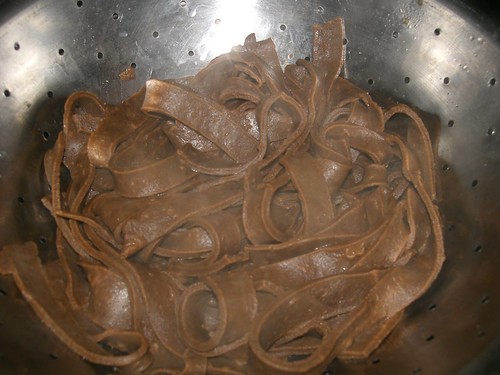





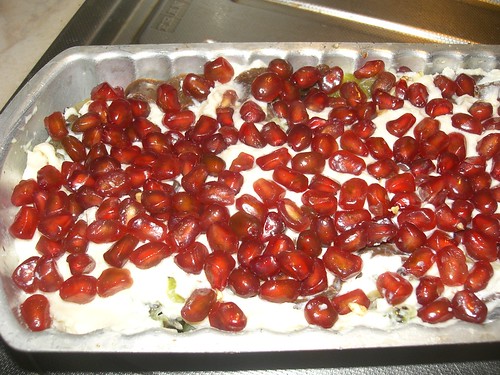





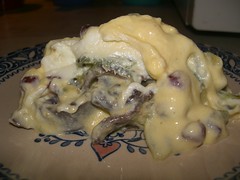
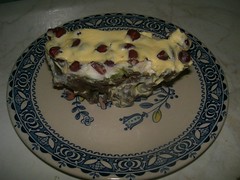
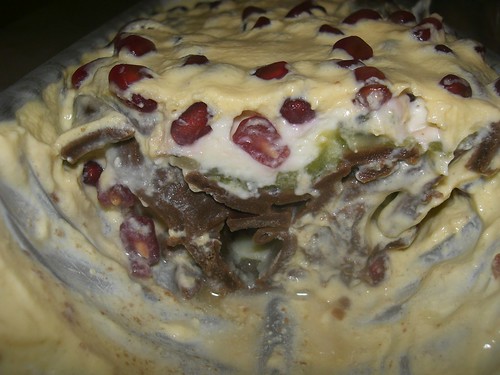
Wow Maria. Really wow! You've outdone yourself in creativity. I'm very impressed! PASHoK - HAHAHAHA!!
ReplyDeleteI've never had anything like this! I've seen, but not had chocolate noodles. Do you believe I've never had a pomegranate seed! That creamy brandy sauce looks so good, and I love those kiwi peeking out. What a cool idea for a unique dessert!
ReplyDeleteNever thought of dessert with pasta.Just last week I tried making some home made pasta,the recipe failed miserably.With cocoa and a positive kid review,I'm definitely gonna try your recipe.Poms are not in season here,guess I could use some strawberries.
ReplyDeleteHappy Valentine's day !
Please trail back to my blog for a token of gratitude:)
I would totally eat this! I'm not bothered by the juxtaposition of flavors and textures from what is considered the norm. For instance, I love champorado, a chocolate rice porridge. Not all work out but I like to try it anyway. Anyway, I love chocolate in pretty much all form and the custard here looks so creamy and delicious!
ReplyDeleteMy mum used to make Pastistio (the savoury kind) wrapped in individual phyllo parcels. She would freeze these and cook them from frozen as one of those 'emergency meals' - it was very convenient. I'm thinking you can probably do the same with adesert variety of pastitsio - except it would need to be cooked, so perhaps the ingredients would need a bit of change :)
ReplyDeleteWell! You've really outdone yourself on this one Maria! I like it alot...and I dare say those chocky noodles are a real winner! Aaah...pastitso will never be the same again!...(nor does it have to be!...)
ReplyDeletefor those wishing to try this, like i said, omit the mizithra (ricotta) layer, use strawberries if you can't get pomegranate (which really are delicious here), and be a little creative, bearing in mind that you are testing and tasting at the same time
ReplyDeleteMaria, that is very creative! I've never had anything similar to this and would love to taste it as I like trying different foods. Happy Valentine's day!
ReplyDeleteChocolate pasta, oh my goodness - I think I just died and went to heaven :)
ReplyDeleteI must be the only one, but doesn't presentation count for anything...? Although I am usually an "out of the box" person, somethings are better left alone. Too many juxtapositions. Since I can't have a taste, and since you didn't ask... in any case, I would give you an A+++ for effort.
ReplyDeleteWow, this is really different. I would totally try it! Fantastic!
ReplyDeleteLOL at PAShOK!
ReplyDelete~ Lulu
This is so creative! It makes me want to make a batch of chocolate pasta.
ReplyDeleteThis is a really inventive twist on the traditional pastitsio Maria. Excellent!!
ReplyDelete